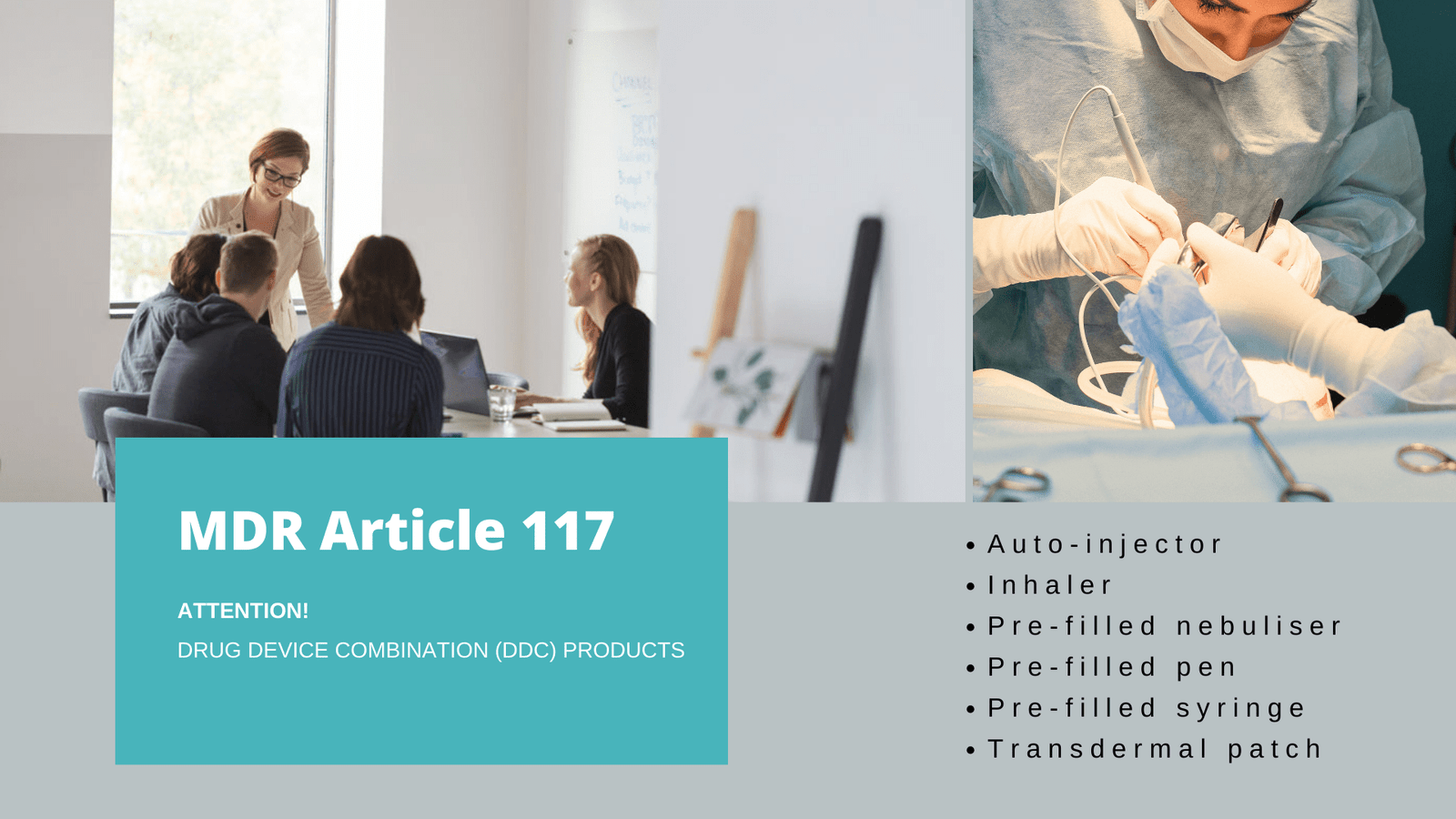Quick Contact

MDR Article 117
Attention pharmaceutical industry, this is for you. MDR Article 117 of the Medical Device Regulation (MDR) 2017/745 has amended Directive 2001/83/EC, Section 3.2, Point 12, mandating the involvement of a Notified Body for the issuance of a “Notified Body Opinion” (NBOp) for drug device combination products as a single integral device. Manufactures can use the NBOp to include it in the Market Authorization Application (MAA) to the European Medicines Agency (EMA).
The above article is applicable for devices where the manufacturer’s EU declaration of conformity and the relevant EU certificate issued by a notified body are not available.
Drug Device Combination Products
For a better understanding, drug device combination products, also known as integral products, are defined as follows:
- A medical device that incorporates a drug or medicinal substance as an integral part that, if used separately, is considered a drug or medicinal product and whose substance action is principal Examples; medicinal products with embedded sensors.
- A medical device intended to administer a drug or medicinal product that constitutes a single integral product intended exclusively for use in combination and which is not reusable Examples; single-use pre-filled syringes, drug-releasing intrauterine devices, and single-use pre-filled dry powder inhalers.
Non Drug Device Combination Products
Medicinal and device components that are not physically integrated during manufacturing but are combined before human administration, so-called non-integral products, are not covered in drug-device combination products. Such types of products are detailed below.
- Co-packaged products – The medicinal product and the medical device are placed on the market and packed together into a single pack.
- Reference product – The medicinal product information (SmPC and/or package leaflet) is for a specific medical device that must be obtained separately.
A few examples of non-integral products are: cups, spoons and syringes for oral administration, refillable pens and injectors using cartridges, nebulisers, vaporisers, pumps for medicinal product delivery and electronic tablet dispensers.
- Ancillary Medical Devices – If the device incorporates a substance as an integral part that, if used separately, is considered a medicinal product, but the action of the substance is ancillary to that of the device. Examples are intrauterine device (IUD)
With the new MDR 2017/745, Article 117 has brought significant impact. It now requires that the device portion of integral drug-device combination products must have an evaluation from a Notified Body to ensure compliance.
MDR Article 117 Regulatory Framework
The new Medical Devices Regulation (MDR) 2017/745 (EU) sets stringent requirements on medical device manufacturers and notified bodies and broadens the scope to include the pharmaceutical industry about pharmaceuticals with a medical device as an integral component.
To determine whether a device part complies with the pertinent general safety and performance requirements (GSPR) of Annex I, a notified body must be involved by Article 117 of the MDR, which amends Directive 2001/83/EC, point 12 of Section 3.2.
Notified Body Opinion Report (NBOp)
A Notified Body conformity assessment of drug-device combination products coming under the preview of MDR Article 117 entails an examination of the technical documentation in relation to all applicable General Safety and Performance Requirements (GSPRs) stated in Annex I of the MDR.
After the technical documentation review is completed successfully, a Notified Body will issue an Notified Body opinion (NBOp) Report. This opinion can subsequently be included in the drug device combination product’s Marketing Authorization Application (MAA) submitted to a drug competent body such as the European Medicines Agency (EMA).
NBOp and Role of I3CGLOBAL Consultants
- Establish the product falls under Drug-Device Combination / integral product,
- Define the product’s intended purpose and mode of action to understand which part of the combination is principal and which part is ancillary,
- Consultants with Pharmaceutical and Medical Device regulatory experience will understand the product and make the route plan,
- Confirmation of Device risk class and regulation number,
- Identification of harmonised and non-non-harmonized standards,
- Biological Evaluation,
- Risk analysis and benefit-risk analysis,
- Clinical Evaluation of Medical Device,
- Device usability, sterility, packaging and transportation,
- Document compilation as per GSPR,
- Support the manufacturer to Identify the Notified Body,
- Support NB application
- Coordinate and respond to the Notified body during the technical documentation review
- Document Control and revision updates throughout the NBOp process.
I3CGLOBAL offers a team of QARA experts to assist with arranging NBOp letters, by preparing technical documentation, interacting with Notified Bodies, by correctly implementing requirements to ensure compliance with Article 117 of the MDR.
Frequently Asked Questions
Which documents are required to be submitted to the Notified Body?
Timeline for NBOp Letter
After providing the technical documentation in accordance with the GSPR, the NB will conduct a preliminary review and accept the file. Typically, the full initial review of technical documentation takes 10 to 12 weeks. The timeline for the entire review process is determined by the compliance and objective evidence submitted against each section of the GSPR. The timeline is determined by the number of additional review rounds and questions posed by the notified body, as well as the manufacturer’s responsiveness in appropriately addressing the review points.


